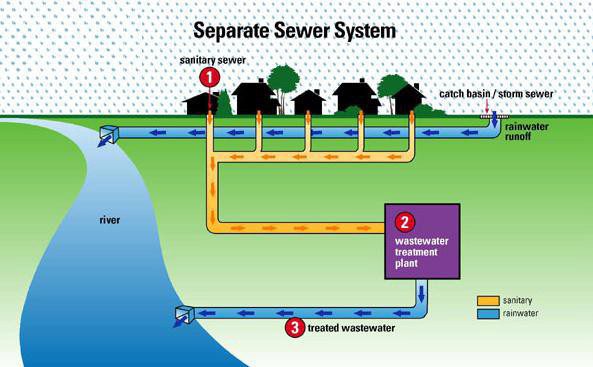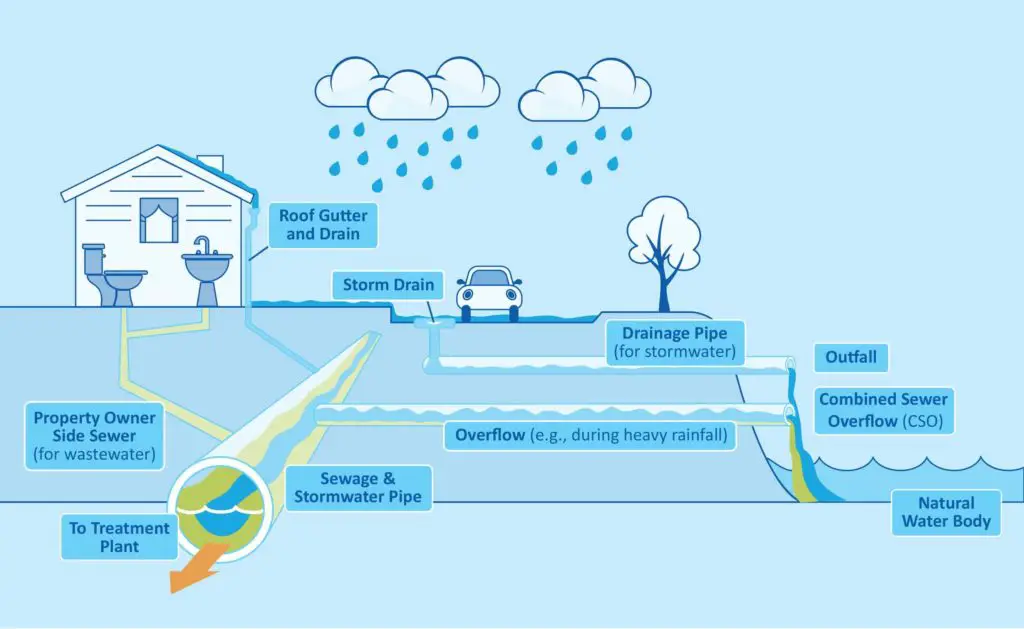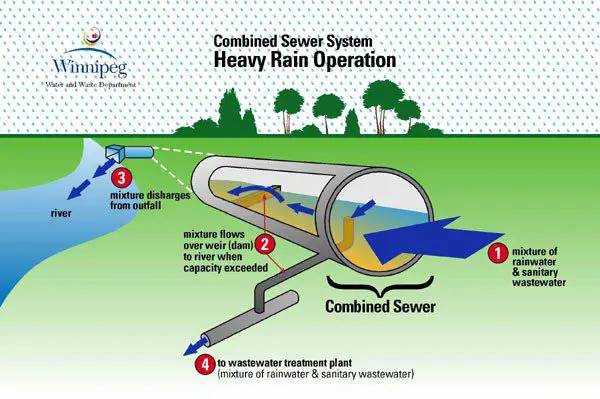A sewerage system also referred to as a wastewater collection system.
It is a network of pipes, pumping stations, and other equipment that carries sewage from its point of origin to its point of treatment and disposal.
In this article you’ll learn:
- purpose of the sewerage system.
- Types of the sewerage system.
- Merits and Demerits of the sewerage system.
- Lots more.
So, if you’re ready to go with a sewerage system, this article is for you.
Let’s dive right in.
What is Sewerage System?
The sewerage system is the architecture that utilizes sewers to transport sewage or surface runoff (stormwater, meltwater, and rainwater).
A receiving drain, manholes, pumping stations, storm overflows, and screening chambers are a few examples of the components of the combined sewer or sanitary sewers that are included.
At the point of discharge into the environment or the entrance to a sewage treatment facility, sewerage comes to an end.
The system of chambers, pipes, manholes, is transports sewage or stormwater.
Purpose of Sewerage System:
- The first effective sewage systems were most likely formed out of a need to eliminate offensive odours because people were aware of the health risks associated with human waste.
- While the majority of settlements were built next to natural waterways where sewage from latrines could be easily dumped, the emergence of large cities exposed the shortcomings of this approach.
- A sanitary sewer system’s primary job is to safeguard the public’s health and water quality.
- Sewage is moved from residences, places of business, and factories to wastewater treatment facilities where it is vacuumed and released directly into the ecosystem using a system of underground pipes, manholes, pumping stations, and other accessories.
Types Of Sewerage and Drainage System:
1. Separate Sewerage System:
In this system, two separate sets of sewers are used to transport sanitary sewage and stormwater.
While the sewage is being transported to a wastewater treatment plant, the stormwater is released into rivers untreated (WWTP).
The separated system is appropriate when a completely separate stormwater outlet is accessible and the topography permits stormwater to be disposed of in natural drains.

Public Sewerage System:
The drain that links a property to other drains serving similar purposes is known as a private sewer.
A public sewer is typically thought to start where two or more drains from different properties converge.
Water companies are in charge of maintaining public sewage systems.
Storm Drain:
A storm drain is also known as a storm sewer.
It is the type of drainage system used to remove excess rainwater and groundwater from impervious surfaces like paved streets, parking lots, footpaths, sidewalks, and roofs.
Storm drains originate in a range of sizes from modest residential dry wells to massive municipal systems.
On the majority of highways, freeways, towns in flood-prone areas and coastal towns with frequent storms, drains receive water from street sewers.
Conditions Favorable for Separate System:
- It is more cost-effective to adopt a separate system when rainfall is unpredictable or concentrated for a brief time of the year.
- Separate sewage as well as stormwater outlets (or Rain Water).
- Adoption of this system will lessen the strain on pumps when it comes to pumping sanitary or domestic sewage as well as industrial sewage.
- Limitations of the Funds
- If the terrain is level, the sewers must be installed at a specific depth below the surface of the ground in order to achieve the necessary gradient.
- Since the area has steep slopes, moving stormwater would be simpler.
Merits of Separate System:
- Only sewage is brought to the treatment facility, which reduces the strain on the infrastructure.
- The sewer is a malleable size, making it affordable.
- The system shows itself to be cost-effective when pumping is necessary.
- Natural or stormwater is not needlessly contaminated by sewage.
Demerits of Separate System:
- Sewer cleaning is challenging because of its small size.
- It takes some effort to reach the self-cleansing velocity.
- Only during the rainy season are the storm drains operational, the dry season presents a risk of garbage choking them.
- High maintenance costs.
- Since sewage sewers are provided beneath storm sewers, the depth and pumping at wastewater treatment plants are increased (WWTP).
2. Partially Separate Sewerage System:
This system is a compromise that combines the best elements of separate and combined systems.
In this system, one system of sewers carries the sewage and stormwater from buildings, while another system of sewers carries the stormwater from roads, streets, pavements, etc.

Vacuum sewer:
A vacuum sewer also known as a pneumatic sewer system transports sewage from its point of origin to a sewage treatment plant.
Inside the pipe network and vacuum station collection vessel, air pressure below atmospheric pressure is maintained.
Pressure sewer:
In a sanitary sewer system, wastewater is transported through small diameter pipes to a collection and treatment system using a network of grinder pumps.
Reticulate sewer:
A property with reticulated sewers has a connection between the sanitary drain and the reticulated sewerage system (sewer main).
Reticulated sewerage is accessible to the land if it is situated where a drain on the property that provides access to the sewer system.
Merits of Partially Separate Sewerage System:
- The valuable elements of both systems are combined.
- The entry of stormwater prevents silting.
- Household stormwater can be easily disposed.
- The sewers are sized appropriately.
Demerits of Partially Separate Sewerage System:
- The partially separated system has a very small percentage of the bad structures of the combined system.
- The load on pumping and treatment units may increase if stormwater (or rainwater) is allowed into sewers.
- When there is no precipitation and dry outside, the flow velocity will be low and self-cleansing velocity may not be attained.
- Stormwater overflows might need to be provided.
3. Combined Sewerage System:
This system uses a single set of sewers to transport both sewage and stormwater to the WWTP, where they are treated before being dumped.
Domestic sewer system:

Sewage is a category of wastewater that is created by a group of people, also known as domestic sewage, domestic wastewater, or municipal wastewater.
Typically, a sewer system is used to transport it.
Modern sewerage systems:
Sewage systems used today include storm sewers, domestic and industrial sewers, and sewage treatment plants.
When a combined system is used, all sewage and runoff are sometimes provided by a single network of pipes, mains, and outfall sewers.
Merits of Combined Sewer System:
- Due to the larger diameter, cleaning is simple.
- They are cost-effective maintenance.
- Due to sewage’s dilution by stormwater, its strength is decreased.
- This system is cost-effective because it only needs one set of sewers.
Demerits of Combined Sewerage System:
- Sewers may overflow and sustain damage during storm seasons affecting serious health risks.
- On dry days, the combined sewer becomes clogged and smelly.
- Since stormwater is also transported, the load on the treatment plant is higher.
- Storm waterer is unnecessarily contaminated.
- When pumping is required, the system becomes unprofitable.
Also read: Cross Drainage Work | Plumbing Trap | Road Drainage
Conclusion:
According to the discussion above, a variety of factors affect the selection of sewerage system.
To make the final decision of adopting any system, it is necessary to gather, study, and analyse sufficient information about the variables influencing the sewerage system.
A well-considered choice without partiality toward any particular system will turn out to be economical and best for the community the systems will serve.

Related Posts
Rock Quality Designation(RQD): Building Strong Foundations
Spread Footing
Masonry Cement
Plain Cement Concrete
Concrete Efflorescence
Concrete Pile
Stepped Footing
Fineness Modulus of Coarse Aggregates
Difference between Condo and Apartment